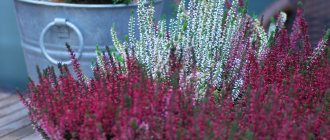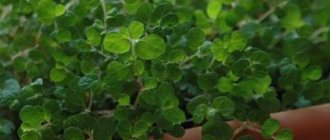Heather, planting and care, description, reproduction
| 1. Growing temperature : heather is kept in fairly cool conditions even during the period of active growth - at a temperature of 17 - 20 ° C. Plants prefer to be kept cool in winter - at a temperature of 5 - 8 ° C. |
| 2. Lighting : for the onset of flowering and subsequent fruiting, plants must take sunbaths in the morning and evening for 3 to 4 hours daily. Shading is possible only during the daytime. |
| 3. Watering and air humidity : plants are watered regularly in spring and summer, when they are actively developing and budding. In autumn and winter, the frequency of watering is reduced in accordance with the air temperature in the room. Only softened water is suitable for irrigation. The flower prefers places with high air humidity. |
| 4. Pruning : Old and diseased shoots are removed by pruning as necessary. To form lush bushes, pinch the tips of the shoots of young plants in a timely manner. |
| 5. Soil : soils that are poor in nutrients and have an acidic pH ranging from 4.5 to 5.5. |
| 6. Feeding : from spring to autumn, heather is fed with organic or liquid mineral fertilizers for flowering plants every 2 weeks. In the fall, feeding is gradually reduced to nothing and is resumed only in the spring, with the first signs of new growth. |
| 7. Reproduction : the heather plant is propagated by rooting apical cuttings or sowing seeds in the spring, as well as by air layering. |
Botanical name: Calluna.
Family . Ericaceae.
The homeland of heather - where it grows . The birthplace of this marsh plant is considered to be South Africa, the Mediterranean, and the Caucasus.
Description. Heather is a profusely branching evergreen shrub with numerous stems and a large number of short side shoots. Heather, as a rule, grows up to 60 cm in height, but some species can reach 1 m. Other names are calluna, erica.
The leaves are very small, scale-like, triangular, and hard.
The colors of the flowers vary from white, pink to purple. The flowering season depends on the variety, usually starting in late July and ending in November. The flowers may remain on the plants throughout the winter. Blooming heather emits a pleasant aroma .
After flowering, the bushes form fruits - seed pods, which become dry as they ripen.
Varieties with decorative foliage have reddish and golden leaves, some are silver-gray. In other species, the color of the leaves changes to yellow and burgundy with the onset of cold weather, which also serves as an additional decoration for the plants.
The plant is most widespread in its natural environment in Scotland - it covers an area of approximately 20,000 kilometers!!!
It is not surprising that many myths and legends - for example, white heather is still added to wedding bouquets and as decoration for the bride’s dress, since it is believed that it brings happiness and good luck to those who wear it.
↑ ,
Home heather - height . About 60 cm , grows quite slowly and can add only 2 cm in height over a season.
The final size of the plant will depend on the varietal characteristics and growing conditions.
2.1.Growing in open ground
It is not at all difficult to grow heather in open ground.
Young plants are planted in open ground at the age of about 2 years , when the threat of the last spring frosts has passed - for example, in the second half of spring . With such planting dates, the heather will have time to take root well and gain strength before flowering.
When purchasing, pay attention to the appearance of the plants - they should have flexible, elastic shoots covered with smooth brownish bark. There should be no plaque on the leaves and stems, and the buds and leaf blades should not be deformed.
↑ ,
For planting, a permanent place is immediately selected, since the heather languishes for a long time after transplantation and it is undesirable to move it from place to place.
For planting, you can choose a slightly shaded, well-moistened place. Before planting, the soil should be acidified, if necessary, with sulfur, leaf compost, high-moor peat or pine needles.
Planting must be carried out together with an old earthen lump - this way the plant will receive with it special fungi - mycorrhizae , with which it exists in symbiosis.
The distance between the bushes should be at least 50 cm , and the root collar should be level with the ground.
A couple of weeks after planting, the heather can be fed with mineral fertilizers for azaleas and rhododendrons - such feeding for adult plants can only be done once a year - in the spring.
If heather is grown in very poor soil, in mid-summer you can apply fertilizers for flowering plants with a high content of phosphorus and potassium.
↑ ,
Since the bushes suffer from frost , they are planted in holes with good drainage at the bottom - for example, coarse river sand can be poured into the hole for better outflow of moisture.
In autumn, faded stems are cut off and the bush itself is covered with them to protect it from severe frost. In young plants, pruning is carried out approximately 5 cm below the tops of the shoots; in older bushes, more severe pruning can be done.
↑ ,
Shelter for the winter is organized around the end of October - beginning of November - the bushes are hilled up, slightly raising the soil around the plants and covered with cut stems, spruce branches or non-woven material.
The shelter is removed in mid-April - when the snow melts.
↑ ,
2.2.Useful properties
- The flower stems of the plant are added to diuretic teas , as it is believed that the plant has a beneficial effect on the urinary system and helps, for example, remove kidney stones.
- Tea made from the flowers is used as an herbal remedy to treat diarrhea, stomach pain and cough. In recent years, heather has been successfully used in Germany to treat rheumatic pain .
- Baths with heather infusion are used for swelling of the legs.
- Alcohol tinctures help in the fight against gout and cystitis.
- Ingestion of heather decoction is indicated for patients suffering from diseases of the gallbladder and liver - it is believed that such a remedy can even dissolve kidney stones.
Heather is harvested for medicinal purposes during the flowering period - it is believed that it is at this time that the plant contains the greatest amount of useful substances.
↑ ,
2.3.Heather in landscape design
The plants are extremely attractive and at the same time unpretentious in maintenance - in this regard, they are widely used in gardening.
Heather bushes fill the garden with a wide variety of shades, depending on the variety, and their compact size facilitates placement in even the smallest corners.
From plants with different flowering times , you can create a flower bed that blooms for several months of the year.
It is difficult to imagine the recently popular rock gardens without these attractive perennials. In addition, flowering heathers emit a pleasant aroma, often intensifying at night.
↑ ,
2.4.Soil
The plant loves soils that are poor in nutrients and have an acidic pH ranging from 4.5 to 5.5 .
For growing a flowering bush, select well-drained acidic soil based on high-moor peat, humus with a sufficient organic content is perfect for growing heather.
The substrate should be loose and easily allow air to pass moisture to the roots of the plants.
Adding finely chopped pine needles to the soil helps maintain the acidic pH of the soil and makes it looser. You can also add a small amount of sulfur to acidify the substrate.
To improve drainage, add perlite, vermiculite or coarse river sand to the growing soil.
When grown in alkaline soil, heather begins to hurt and may even die.
↑ ,
2.5.When does home heather bloom?
Flowering time varies greatly depending on the variety .
2.6.Reproduction, growing from seeds
By dividing adult specimens during transplantation. Make sure that each division receives a well-developed root system and a green ground part.
By apical cuttings and layering - cutting is quite easy.
Mature heather bushes have shoots on their sides, which bend toward the ground with age and take root independently upon contact with the ground.
Source: https://zelenypodokonnik.ru/vereskovye/220-veresk
Common heather (Calluna vulgaris) plant description, care and diseases, watering and propagation
Ericaceae family Description
Common heather (Calluna. Vulgaris) is a low-growing (creeping or ascending), evergreen, dense, branched shrub, rarely growing above 30 cm. Its branches are covered with narrow evergreen small leaves, among which mauve flowers resembling bells open at the end of summer. They are collected in paniculate multi-flowered inflorescences at the ends of the branches. The root system of heather is fine-fibrous and densely branched, with a long and widely branched main root.
The most important condition for the existence of plants of this family was their “cohabitation” (symbiosis) with fungi. Mushroom threads closely entwine heather roots, supplying them with nitrogen and other nutrients from the soil. Plants without mycorrhizae die, despite careful care.
Therefore, anyone who wants purchased varietal heather or wild heather brought from the forest to take root in their garden plot should take a walk into the forest and collect land among the thickets of its close relatives, such as blueberries or wild rosemary. If necessary, add three parts of peat and one part to two parts of the soil you brought...
Calluna mix care and planting
SoilSizeFlowering timePossible colorsIlluminationWateringDifficulty of careAir humidityFertilization frequency
|
|
|
|
|
|
- 1. Description
- 2. Growing
- 3. Diseases and pests
- 4. Reproduction
- 5. First steps after purchase
- 6. Secrets of success
- 7. Possible difficulties
Only one species belongs to the genus Heather - Common Heather. But the number of very decorative varieties reaches 300 and continues to increase thanks to the efforts of breeders, which indicates the great popularity of this amazing plant.
Heather is often confused with the charming representative of the numerous Heather genus (Ericaceae) - Erica, but despite all the external similarities they have noticeable differences.
This shrub has always been a legendary plant in the cultures of many countries. In Norway it is the national flower.
According to Scottish legend, when God distributed plants throughout the earth, only Heather agreed to live on their poor, windswept soil. For which he was awarded special endurance, exquisite beauty and amazing durability.
An evergreen, fast-growing shrub that can be creeping or highly branched. It has very decorative foliage in various shades of green (from light green to silver gray).
Some varieties have foliage that is red, orange, bronze, or gold. The leaves are small, whorled, narrow, oblong (0.5-2 cm), triangular, sometimes pubescent. They give the shrub a special modest charm.
But when the Heather blooms, it becomes a bright star and a decoration of the house or garden for a long time.
Small, barrel-shaped bells are formed by four to five simple or partially fused petals of incredible colors.
Even Heathers with double and super-double flowers have been bred, as if strewn with small fragrant roses. They almost completely cover the bush, turning it into a blooming outbreak.
Small flowers are collected in lush pyramidal or round paniculate inflorescences.
The flavonoids, arbutin, and resins contained in the plant make it indispensable in medicine in the treatment of a huge number of diseases. The leaves are also used to make dye for the fabrics of the famous Scottish kilts and rugs.
Heather has a delicate aroma and is an excellent honey plant.
Growing
In nature and gardens, Heather blooms from June to August, but at home, flowering may shift to October-March. Withered flowers dry out without losing color, and remain on the plant for several months, maintaining its high decorative value. Therefore, they can not be cut for a couple of months. But if dried flowers are removed, other branches will grow and bloom more abundantly.
Heather is an unpretentious plant. There are some features of its cultivation that need to be taken into account, then it will delight you with its flowering for many years. After all, Heather lives up to 30 years.
In a temperate climate, for the summer the bushes can be moved to the balcony, even to a sunny place, not forgetting about frequent watering and spraying.
For more luxuriant branching and flowering, branches are pinched. After flowering ends, the bush is subjected to formative pruning.
Reproduction is possible in a greenhouse or greenhouse. Seeds and cuttings take root well, but flowering occurs in 3–5 years. Therefore, it is easier to purchase an already mature plant at the beginning of flowering.
Diseases and pests
Late blight, fungal and viral diseases (gray rot, powdery mildew), spider mites, aphids.
Reproduction
By seeds, air layering and apical cuttings, division of rhizomes.
First steps after purchase
When purchasing such a beautiful plant as Heather, you should pay attention to the condition of the branches and flowers. The fact is that a bush can die from even short-term drying out of the soil during transportation.
This will not affect the appearance at all. It does not lose its decorative effect for months and stands perfectly as a dried flower. But I still want to get this treasure alive. Therefore, you need to check the condition of the plant before purchasing it.
The branches should be flexible, alive, and the flowers should not fall off.
Having brought Heather into the house, it is worth giving it a short cool shower, which will wash away possible pests (especially spider mites) and have a beneficial effect on the plant. Immediately place the pot with the plant on a tray with wet peat or pebbles.
Secrets of success
For Heather, acidic (pH 4.5–5.5) not very nutritious, but loose soil is suitable, which should be constantly moist, but without soaking. It is very important to have good drainage, otherwise the plant may quickly die.
The plant should be watered and sprayed frequently with well-settled soft water at room temperature. During the dormant period, watering is reduced and fertilizing is not done at all.
During the growing season and flowering, the plant responds well to fertilizing with organic fertilizers once a month. At the beginning of spring you need to replant it and feed it once with full mineral fertilizer.
Very interesting is the symbiosis of Heather with some types of soil fungi, which help it absorb nutrients and enrich the soil. The result is heather soil, which can later be used for planting Hydrangeas, Azaleas and plants that prefer acidic soils.
Heather loves cool rooms, fresh air and lots of sunlight. at low temperatures of +7–12°C in winter and up to +20–24°C in summer will not allow Heather to die. It does not tolerate even short-term overdrying of the soil and hot, dry air. Frequent spraying will do him good.
Possible difficulties
The bush grows slowly
Reason: 1) excess nitrogen in the soil, 2) inappropriate soil acidity.
Branches and flowers dry
Reason: 1) non-compliance with the irrigation regime and overdrying of the soil, 2) excessive dryness of the air, 3) insufficient acidity of the soil.
The leaves turned brown and the young shoots withered
Reason: 1) waterlogging and stagnation of water in the soil, 2) excess nutrients.
A grayish-white coating appeared on the leaves
Reason: 1) powdery mildew.
Subscribe and receive descriptions of new species and varieties in the “ornamental trees and shrubs” section by email!
Growing Calluna (Calluna Vulgaris) - description and characteristics
Petunias grow on my balcony all summer, but in winter the boxes are empty. One friend advised planting heather in them in the fall - they say it will stick out with colorful caps all winter, decorating the balcony. I didn’t doubt it for a long time; that same year I planted four varieties at once. And they all withered away happily.
I don’t like to leave things halfway, and if something doesn’t work out, I rush to figure out what went wrong. I went to the garden center for a consultation.
It turned out that the soil in which the petunias grew and which I carefully fed with mineral water after them was not suitable for the heather.
Since on the one hand it is an unpretentious flower, but on the other hand, if the soil was chosen incorrectly, you will not get beauty from the semi-shrubs.
Ordinary, yet amazing heather
There are more than a hundred plants in the Heather genus, but there is only one species called heather - common heather, or, speaking in the language of science, calluna vulgaris.
Thanks to the fact that breeders have long taken up the plant, calluna can please you with three hundred varieties, distinguished by different colors and shades of leaves and flowers.
The advantages of this shrub:
- it is decorative throughout the year - even when the flowers fade, they dry out and do not fall off the branches, continuing to look beautiful all winter;
- in our latitudes, evergreen heather does not need shelter for the winter, and when light snow dusts a heather garden or flowerbed, it looks very beautiful;
- this creeping crop quickly overgrows an open yard.
leaves can be all shades of green and light green, silver, golden, bronze, orange and red. The leaf blades are narrow, often with a smooth surface, less often pubescent.
The stem grows up to 25 cm upward.
The flowers resemble small bells, consisting of 4-5 fused petals. Sometimes there are varieties with double and even super-double flowers, reminiscent of small roses. Either way, they smell very nice. There are always bees swarming over the heather; it is a good honey plant.
You can admire the flowering of the subshrub from June to August . But this is only if it grows in the garden. Indoor calluna can bloom from October to March .
Source: https://stone-masters.ru/sad/kalluna-miks-uhod-i-posadka
Ordinary, yet amazing heather
There are more than a hundred plants in the Heather genus, but there is only one species called heather - common heather, or, speaking in the language of science, calluna vulgaris.
Thanks to the fact that breeders have long taken up the plant, calluna can please you with three hundred varieties, distinguished by different colors and shades of leaves and flowers.
The advantages of this shrub:
- it is decorative throughout the year - even when the flowers fade, they dry out and do not fall off the branches, continuing to look beautiful all winter;
- in our latitudes, evergreen heather does not need shelter for the winter, and when light snow dusts a heather garden or flowerbed, it looks very beautiful;
- this creeping crop quickly overgrows an open yard.
leaves can be all shades of green and light green, silver, golden, bronze, orange and red. The leaf blades are narrow, often with a smooth surface, less often pubescent.
The stem grows up to 25 cm upward.
The flowers resemble small bells, consisting of 4-5 fused petals. Sometimes there are varieties with double and even super-double flowers, reminiscent of small roses. Either way, they smell very nice. There are always bees swarming over the heather; it is a good honey plant.
You can admire the flowering of the subshrub from June to August . But this is only if it grows in the garden. Indoor calluna can bloom from October to March .
By the way, not everyone knows, but in the old days brooms were made from this plant. Actually, that’s why it’s called calluna (“kallunein” from Greek - “to cleanse”).
The use of heather in landscape design
The plant can be “made friends” with other crops (for example, by arranging it in the form of a border), or you can rely only on calluna, forming a heather garden . In this case, the heather can grow on the ground in a continuous carpet, in which one variety passes into another, dividing into multi-colored sections.
Or calluna in a heather garden can be slightly “diluted” with other plants and stones, creating the illusion of a “wild” landscape.
Also, this crop fits beautifully into alpine hills and looks impressive in combination with tall plants, especially conifers or beautifully flowering shrubs.
Calluna mix care and planting – Cottage, garden, vegetable garden, indoor plants
- 1 Calluna: description, cultivation, care, photo
- 2 Common heather (Calluna vulgaris): description, planting, cultivation and care in open ground
- 3 Heather - 4 ways to propagate a plant with unique medicinal properties
- 4 Heather (Calluna) - description, cultivation, photo
- 5 Heather, planting and care, description, reproduction
Petunias grow on my balcony all summer, but in winter the boxes are empty. One friend advised planting heather in them in the fall - they say it will stick out with colorful caps all winter, decorating the balcony. I didn’t doubt it for a long time; that same year I planted four varieties at once. And they all withered away happily.
I don’t like to leave things halfway, and if something doesn’t work out, I rush to figure out what went wrong. I went to the garden center for a consultation.
It turned out that the soil in which the petunias grew and which I carefully fed with mineral water after them was not suitable for the heather.
Since on the one hand it is an unpretentious flower, but on the other hand, if the soil was chosen incorrectly, you will not get beauty from the semi-shrubs.
The use of heather in landscape design
The plant can be “made friends” with other crops (for example, by arranging it in the form of a border), or you can rely only on calluna, forming a heather garden . In this case, the heather can grow on the ground in a continuous carpet, in which one variety passes into another, dividing into multi-colored sections.
Or calluna in a heather garden can be slightly “diluted” with other plants and stones, creating the illusion of a “wild” landscape.
Also, this crop fits beautifully into alpine hills and looks impressive in combination with tall plants, especially conifers or beautifully flowering shrubs.
Growing calluna
The most important thing in caring for calluna vulgaris is to plant the heather correctly. In this case, it can grow in the yard for up to 30 years, and bloom brightly all this time.
But buying is also important. The fact is that stores sometimes have completely dry calluns, which the sellers forgot to water in time. They can be beautiful for up to 4 months, because the flowers will not fall off.
But you can’t plant this “charm” either in the yard or on the balcony. So before you give money for a bush, check whether its branches bend - if so, the bush is alive. It is also important that the soil in the pot is slightly damp when selling.
Landing
Soil . It's the most important. It may not be very nutritious, but it is loose and necessarily sour. If you buy soil for a home flower in a store, make sure that the pH numbers on the package are between 4.5 and 5.5.
If you have a flowerbed and you don’t know what acidity the soil is, you can buy special test strips (they are available in flower shops). You can acidify the soil by digging it with fresh manure, sphagnum moss, leaf compost, rotted sawdust or pine needles, and high-moor peat.
It is also important that there is drainage - without it, heather, which loves to grow in wet soil, may die from root rot.
Other Important Requirements:
- sunny area (partial shade allowed);
- good soil water supply;
- moist soil (low groundwater is not bad for heather, especially newly planted), but the flower garden should not be swampy.
An experienced gardener will tell you in more detail about planting this ornamental crop in spring and autumn, as well as the intricacies of this procedure:
Outdoor care
- Abundant watering for the winter, especially in cold regions (and calluna can grow even in Siberia).
- Pests are not terrible for heather, but it can get sick to death from late blight. Therefore, flower beds should not be planted close to the vegetable garden and beds, so that the heather does not have contact with crops that often suffer from such a disease (potatoes, tomatoes).
- In a warm or middle climate, the semi-shrub does not need shelter for the winter, but in the north it is better to cover the flower bed with spruce branches (although a lot depends on the type of flower you planted; they can be less or more winter-hardy).
- Mulching with materials that acidify the soil: pine needles or fine bark, sawdust, leaf humus.
But there is no need to feed the calluna in the flowerbed.
You can learn more about growing calluna from a garden center expert:
Home care
- Ideal content for calluna: about 22 degrees in summer and from +7 to -12 in winter; frequent ventilation; a lot of sun. In warm regions, heather can be kept on the balcony in winter, and in an apartment under air conditioning in summer.
- Immediately after bringing the bush from the store, give it a warm shower - this way you will wash off the dust, and perhaps also some of the pests that have clung to the store.
- Make sure that the soil in the pot does not become swampy, but is always slightly moist. Heather also needs moist air, so it is advisable to constantly (especially in summer and winter) keep it on a tray with wet sphagnum or expanded clay. In winter, watering is reduced.
- The plant can be sprayed frequently. For both irrigation and spraying, water must be settled. During the procedure, the water should be lukewarm or room temperature.
- You can feed calluna with organic matter, giving it once a month in spring and summer. And in the first month of spring, after a planned transplant, the plant can be watered with a solution of complex mineral fertilizer.
- Indoor calluna requires pinching - thanks to it, the plant bushes better, and therefore blooms more. And when all the flowers dry out, it’s time for formative pruning.
- If you have a temperate climate, place the bushes on the balcony every summer. It could even be the sunny side of the house. But remember: the more sun the heather receives, the more water it should receive (not only watering, but also spraying).
Trimming
This is an important part of caring for both indoor and outdoor heather. It delays the aging of calluna, stimulating the plant to bush and bloom more.
It is held once a year. In open ground, it can be done in early spring, when the plant has already overwintered, but does not have time to start growing. In a pot, pruning can be done after the heather has faded (but since you are unlikely to want to part with flowering branches before the deadline, you can also postpone it until spring).
Important! It is necessary to cut along the green part of the stem (areas with leaves), without touching the lignified areas . If you shorten a bush right down to the wood, it will dry out, because new branches will not grow from such a stem.
When forming a flowerpot, do not make the heather into a regular ball; do not shorten different branches to the same length. This culture looks good in its natural, slightly “wild” form.
Features of care
At home, the principle of caring for any type of decorative heather is approximately the same, although some still require special conditions.
What should a gardener do and remember? How to care for heather at home?
- First of all, you will need a well-ventilated room in which the temperature in winter does not exceed +7-12°C (this condition is mandatory for the life of the plant and its flowering in winter).
- Heather does not tolerate heat very well.
- The plant must have enough light.
- Growing heather at home requires timely watering. The soil should always be moderately moist, and water can only be used for watering and spraying the plant if it has settled and contains a minimum amount of chlorine. Rain or melt is very suitable. When watering, you should try not to get it on the leaves of the bush, as otherwise it may begin to suffer from a disease such as gray rot.
- As a nutrient medium for growing the plant, it is recommended to take a mixture of marsh and coniferous soil, as well as sand and peat (parts ratio 3:1:½:1).
- Heather, which is a troublesome but fascinating task to care for at home, is very sensitive to fertilizing, so it should be fertilized very carefully so as not to overdo it. A full range of mineral fertilizers for heather is applied in the spring immediately after pruning. The fertilizer calculation is as follows - from 20 to 30 milligrams per square meter of soil.
- To stimulate growth and give shape, the bush must be pruned, while avoiding woody shoots, because it is from them that new branches begin to grow.
It is worth noting that common heather behaves unpretentiously at home - it is a completely unpretentious plant to plant and care for.
Heather (Calluna) - description, cultivation, photo
Only one species belongs to the genus Heather - Common Heather. But the number of very decorative varieties reaches 300 and continues to increase thanks to the efforts of breeders, which indicates the great popularity of this amazing plant.
Heather is often confused with the charming representative of the numerous Heather genus (Ericaceae) - Erica, but despite all the external similarities they have noticeable differences.
This shrub has always been a legendary plant in the cultures of many countries. In Norway it is the national flower.
According to Scottish legend, when God distributed plants throughout the earth, only Heather agreed to live on their poor, windswept soil. For which he was awarded special endurance, exquisite beauty and amazing durability.
An evergreen, fast-growing shrub that can be creeping or highly branched. It has very decorative foliage in various shades of green (from light green to silver gray).
Some varieties have foliage that is red, orange, bronze, or gold. The leaves are small, whorled, narrow, oblong (0.5-2 cm), triangular, sometimes pubescent. They give the shrub a special modest charm.
But when the Heather blooms, it becomes a bright star and a decoration of the house or garden for a long time.
Small, barrel-shaped bells are formed by four to five simple or partially fused petals of incredible colors.
Even Heathers with double and super-double flowers have been bred, as if strewn with small fragrant roses. They almost completely cover the bush, turning it into a blooming outbreak.
Small flowers are collected in lush pyramidal or round paniculate inflorescences.
The flavonoids, arbutin, and resins contained in the plant make it indispensable in medicine in the treatment of a huge number of diseases. The leaves are also used to make dye for the fabrics of the famous Scottish kilts and rugs.
Heather has a delicate aroma and is an excellent honey plant.
Calluna vulgaris (Common heather)
Family. Ericaceae, Ericaceae.
Origin. Europe, Siberia, Asia Minor.
Flowering time. June - November.
Heather is a dwarf, 20-90 cm in height, shrub with narrow, scaly leaves of green, yellow or gray-green color. Pink, red or white flowers, similar to bells, are collected in dense pyramidal inflorescences at the ends of the shoots. There are simple and double varieties that bloom at different times of the year.
With proper care, you can get a closed carpet of heather plants, which is quite picturesque both in independent heather gardens and on alpine hills, or as a border along paths in a country garden. Heathers look impressive in joint plantings with decorative forms of conifers and beautiful flowering shrubs. As a rule, heathers form the foreground, and tall bushes form their background.
Accommodation. In a sunny or semi-shaded place, outdoors, in sandy soil.
Care. In summer, maintain low humidity at all times. Feed in spring and early summer. In winter, reduce watering, but the plant should not dry out. Prune in spring.
Reproduction. In summer cuttings or...
Calluna: description, cultivation, care, photo
Petunias grow on my balcony all summer, but in winter the boxes are empty. One friend advised planting heather in them in the fall - they say it will stick out with colorful caps all winter, decorating the balcony. I didn’t doubt it for a long time; that same year I planted four varieties at once. And they all withered away happily.
I don’t like to leave things halfway, and if something doesn’t work out, I rush to figure out what went wrong. I went to the garden center for a consultation.
It turned out that the soil in which the petunias grew and which I carefully fed with mineral water after them was not suitable for the heather.
Since on the one hand it is an unpretentious flower, but on the other hand, if the soil was chosen incorrectly, you will not get beauty from the semi-shrubs.
Let's summarize
- Calluna is the Latin name for heather. This decorative shrub is represented by 300 varieties with different shades of leaves and fragrant flowers.
- The plant can be grown in an apartment. It needs to be watered regularly, kept in moist air, and pinched in the spring.
- But of course, more often heather is planted in flower beds. The creeping plant quickly forms a colorful carpet. It is important that the soil under the crop is acidic.
And you will learn about the most popular varieties of calluna and why it does not always take root in the garden or balcony box from this video:
Source: https://sornyakov.net/flowers/kalluna.html
Features of planting heather
Heather prefers the climate of central Russia, prefers open sunny places, or at least partial shade. When planting heather, keep in mind that it loves acidic, loose soils and does not tolerate calcareous and alkaline soils at all. The ideal soil substrate for it: peat mixed with sand, pine soil and sawdust in a ratio of 3:1:1:1. Coniferous soil is taken from a depth of 5-6 cm from a spruce or pine forest. And if you manage to get high-moor peat, then you don’t need to add sand to the soil mixture. It is useful to add 70-80 g of sulfur per 1 m³ of soil.
Planting pit
From the place intended for planting heather, remove the top soil using 1 spade and replace it with soil mixture. Then lightly trample the soil, walking along it in small steps, and pour in plenty of slightly acidified water (for example, 100 ml of 6% apple cider vinegar per 10 liters of water).
Boarding time
Heather can be planted both in spring and winter. But it is preferable in the spring, then the heather will have time to take root properly and will survive winter frosts well.
Planting a seedling Make planting holes at a distance of 40-50 cm from each other, their size should be 2 times larger than the root ball. If the soil on your site is clayey, add drainage (pebbles, crushed stone, broken brick) to a height of 2-3 cm into each one. When placing seedlings, keep in mind that heather roots grow horizontally, but in containers with seedlings purchased at a nursery, they are crowded together center. Therefore, before planting, spread its roots to the sides as carefully as possible. Dig the seedling down to the level of the root collar. After planting, lightly compact the soil with your hands, water generously and mulch the base of the seedling with peat or sawdust, and best of all, with small chips from the bark of coniferous trees.
Glades of blooming heather
Stunningly beautiful, isn't it?
Reproduction
Several methods are suitable for it: seeds, layering, dividing the bush and apical cuttings.
Reproduction by layering Heather can also reproduce independently by layering. Over time, the main trunk and old branches lie down and take root on their own, giving birth to numerous shoots, so the heather in the country should be fenced with a small fence or other limiter. And if you want to help your favorite honey plant, sprinkle the mature shoots with 1-2 cm of peat and fix them in the soil. A year after the powdering, you will receive a ready-made seedling, which should be separated from the mother bush and planted in a separate hole.
Propagation by seeds Heather can be grown from seeds, but this is a rather lengthy process. First, the seeds are placed in bowls, scattered in a thin (2-3 mm) layer, moistened and covered with glass. After 2-3 weeks, the seeds will germinate, and then they are sown in wooden boxes with soil substrate, the composition of which is described above. Sprouts usually appear within a month. The temperature regime for the full development of seedlings is +18. +20°C. Remember to maintain moderate soil moisture in the boxes. In the summer, containers with seedlings are periodically taken out into the open air for hardening. Heather seedlings will be ready for planting in open ground only after 1.5-2 years.
Propagation by apical cuttings If you already have a decorative honey plant growing in your dacha, at the end of summer, cut cuttings from the strongest branches of the bush (do not take flowering shoots). Root the cuttings in separate pots filled with peat mixed with sand (3:1). Maintain the room temperature +15. +18°С. Once every 2-3 weeks, feed the cuttings with a solution of 1 g per 1 liter of water) urea and microfertilizers. During wintering, the cuttings will take root well, and in the spring they can be planted in open ground.
Propagation by dividing rhizomes This is the simplest and fastest method. At the end of summer, a heather bush is dug up, and the root, without shaking it off the ground, is cut into pieces so that each has young shoots, the old stems are cut off. Then the root with shoots is planted in a separate hole.
Let's summarize
- Calluna is the Latin name for heather. This decorative shrub is represented by 300 varieties with different shades of leaves and fragrant flowers.
- The plant can be grown in an apartment. It needs to be watered regularly, kept in moist air, and pinched in the spring.
- But of course, more often heather is planted in flower beds. The creeping plant quickly forms a colorful carpet. It is important that the soil under the crop is acidic.
And you will learn about the most popular varieties of calluna and why it does not always take root in the garden or balcony box from this video:
Heather - planting and caring for this herbaceous crop in open ground is not difficult. This unpretentious plant is often used in landscape design. It is well suited for delimiting zones with different styles and purposes, looks great against the backdrop of coniferous trees and looks great when decorating paths.











